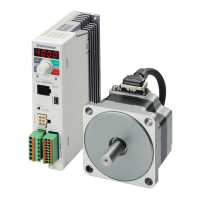Troubleshooting and remedial actions
−
50
−
12 Troubleshooting and remedial actions
An erroneous speed setting or connection may prevent the motor/driver from operating properly.
If proper motor operation cannot be achieved, take an appropriate action by referring to this chapter. If the information
provided here does not help, please contact your nearest Oriental Motor ofce.
Problem Likely cause Corrective action
The motor doesn’t operate.
The power supply is not connected
correctly.
Check the connection of the power supply.
Both the FWD input and REV input are
OFF.
Turn ON either the FWD input or REV input one at
a time.
Both the FWD input and REV input are
ON.
Turn ON either the FWD input or REV input one at
a time.
The internal potentiometer is not adjusted.
The factory setting is 0 r/min. Turn the internal
potentiometer clockwise.
The potentiometer is not selected correctly.
Turn the M0 input OFF when using the internal
potentiometer. Turn the M0 input ON when using
the external potentiometer.
The external potentiometer or external DC
voltage is not connected correctly.
Check the connection of the external potentiometer
or external DC voltage.
The ALARM LED (red) is blinking.
An alarm generated due to a protective function
being triggered. Refer to p.48 to reset the alarm.
Electromagnetic brake is not released.
(electromagnetic brake motor only).
Turn ON the MB-FREE input.
The motor turns in the
opposite direction to the
specied direction.
The FWD input and REV input are
connected wrongly or otherwise not
connected correctly.
Check the connection of the FWD input and
REV input. The motor turns in the clockwise
direction when the FWD input is ON, and in the
counterclockwise direction when the REV input is
ON.
The combination type parallel shaft
gearhead is using a gear with a gear ratio
of 30:1, 50:1 or 100:1.
When the gear ratio of the combination type
parallel shaft gearhead is 30, 50 or 100, the
rotating direction of the gear output shaft is
opposite the rotating direction of the motor output
shaft. Accordingly, reverse the FWD input and
REV input operations.
A combination type hollow shaft at
gearhead is used.
•
With a combination type hollow shaft at
gearhead, the rotating direction of the gear
output shaft is opposite the rotating direction of
the motor output shaft. Accordingly, reverse the
FWD input and REV input operations.
•
Is the gearhead viewed in the correct direction?
With a combination type hollow shaft at
gearhead, the rotating direction of the gearhead
changes according to the direction in which the
gearhead is viewed.
•
Unstable motor operation
•
Large vibration
The motor (gearhead) output shaft is not
misaligned with the load shaft.
Check the coupling condition of the motor
(gearhead) output shaft and load shaft.
Effect of noise.
Check the operation only with the motor, driver and
other external equipment required for operation. If
an effect of noise has been conrmed, implement
the following countermeasures:
•
Move the unit farther away from noise generation
sources.
•
Review the wiring.
•
Change the signal cables to a shielded type.
•
Install ferrite cores.
The motor doesn’t stop
instantaneously.
The STOP-MODE input is ON.
To cause the motor to stop instantaneously, turn
OFF the STOP-MODE input.
The inertial load is large.
Reduce the load inertia or connect the accessory
regeneration unit (sold separately) to check the
inertial load.
The electromagnetic brake
does not hold.
The MB-FREE input is ON. Turn OFF the MB-FREE input.

